👉August Answers and Trivia
👉July Answers and Trivia
👉Jun Answers and Trivia
👉May Answers and Trivia
👉April Answers and Trivia
👉March Answers and Trivia
👉February Answers and Trivia
👉January Answers and Trivia
XENEA Wallet features a Daily Quiz that enhances user engagement while offering a fun and gamified way to learn about Web3 and the Xenea ecosystem.
Although many kind individuals are sharing answers on X (formerly Twitter), it feels like the quiz is turning into a game of simply picking the right answer without understanding the questions. To address this, this article will provide not only the answers to XENEA Wallet’s Daily Quiz but also the reasoning behind them and additional insights. By leveraging XENEA Wallet NAVI (ChatGPT), we aim to make the experience more informative and meaningful.
It takes less than a minute, so bookmark this page and check back daily! 😊
Start Your Journey with XENEA Wallet Today!
XENEA Wallet is an innovative app that makes exploring the world of Web3 both fun and rewarding! Complete simple missions, claim daily bonuses, and earn rewards while learning about the future of digital technology.
With cutting-edge security and unparalleled convenience, XENEA Wallet offers you the chance to participate in future airdrops and mining opportunities. Simply download the app to begin your new digital experience!
New users can start with 1,000 gems by signing up with the invite code below!
1️⃣ Download the app
2️⃣ Enter the invite code: h3dYzHejPI
3️⃣ Sign up with your Google or Apple account
Enjoy the exciting world of XENEA Wallet!
Please refer to the following page for information on how to earn Gems.
How many days does it take to earn 10,000 gems and start automatic mining with the XENEA Wallet?
Daily Quiz on September 30
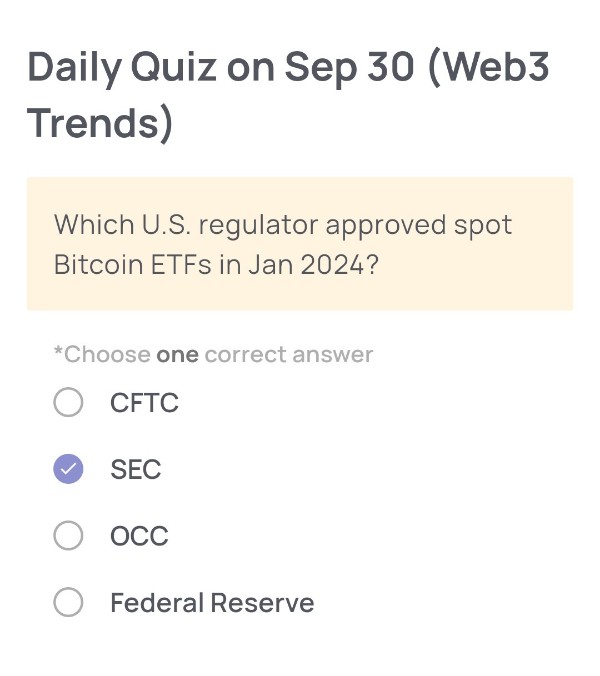
(Web3 Trends)
🟢Quiz Question:
Which U.S. regulator approved spot Bitcoin ETFs in Jan 2024?
🟢Choose one correct answer:
・CFTC
・SEC
・OCC
・Federal Reserve
🟢Answer:
SEC
🟢Reason for choosing this answer:
The U.S. Securities and Exchange Commission (SEC) officially approved spot Bitcoin exchange-traded funds (ETFs) in January 2024 after years of rejecting similar applications. The SEC regulates securities markets and has the authority over ETFs. This was a historic milestone, as it marked the first time that U.S. investors could access Bitcoin directly through a regulated ETF product, boosting institutional adoption.
🟢Trivia:
The approval of spot Bitcoin ETFs led to significant inflows from traditional financial institutions like BlackRock and Fidelity. Within the first month, spot Bitcoin ETFs attracted billions of dollars, making them some of the fastest-growing ETFs in history. This approval was seen as a step toward mainstream acceptance of Bitcoin and may pave the way for other crypto-based ETFs, such as Ethereum.
Daily Quiz on September 29
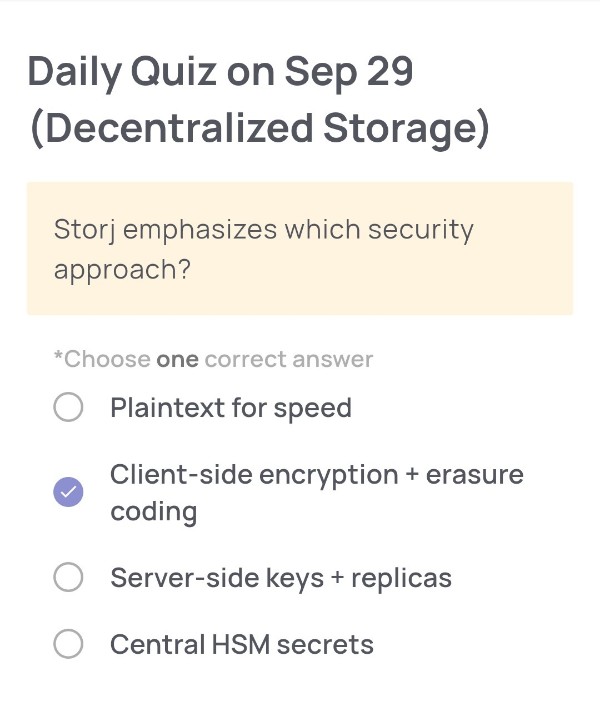
(Decentralized Storage)
🟢Quiz Questions:
Storj emphasizes which security approach?
🟢Choose one correct answer:
・Plaintext for speed
・Client-side encryption + erasure coding
・Server-side keys + replicas
・Central HSM secrets
🟢Answer:
Client-side encryption + erasure coding
🟢Reason for choosing this answer:
Storj prioritizes end-to-end security by encrypting files on the client side before uploading them to the network. This ensures that no storage node can access the plaintext data. Additionally, Storj uses erasure coding (splitting files into multiple redundant pieces and distributing them across independent nodes) rather than simple replication. This method improves both security (no single node holds enough data to reconstruct the file) and reliability (data can be recovered even if several nodes go offline).
🟢Trivia:
Unlike traditional cloud providers, Storj never has access to your encryption keys—meaning you remain the only party in control of your data. This design aligns with zero-trust principles. Erasure coding is more storage-efficient than replication: instead of keeping 3 or more full copies (like Amazon S3), Storj can achieve redundancy with less overhead, reducing costs while maintaining durability comparable to enterprise cloud storage.
Daily Quiz on September 28
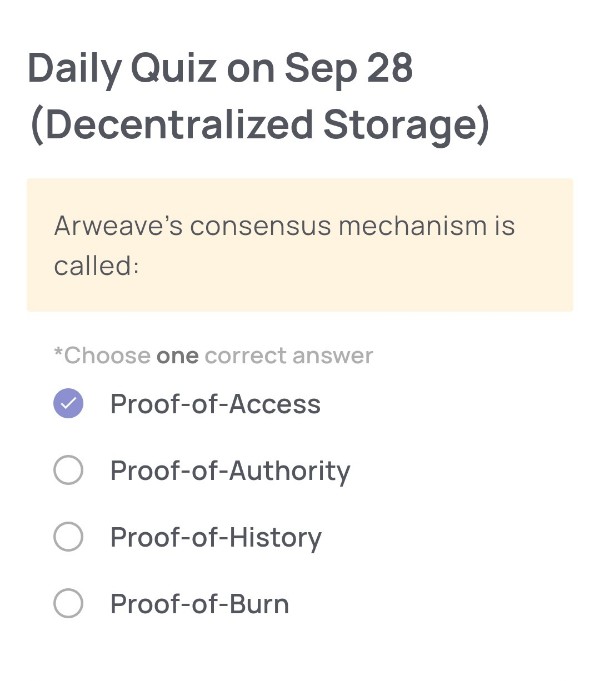
(Decentralized Storage)
🟢Quiz Questions:
Arweave’s consensus mechanism is called:
🟢Choose one correct answer:
・Proof-of-Access
・Proof-of-Authority
・Proof-of-History
・Proof-of-Burn
🟢Answer:
Proof-of-Access
🟢Reason for choosing this answer:
Arweave uses a unique consensus mechanism called Proof-of-Access (PoA). Unlike Proof-of-Work or Proof-of-Stake, PoA requires miners not only to provide computational resources but also to prove that they can access specific prior data from the blockchain’s permanent storage. This ensures that the network incentivizes long-term data storage, making Arweave suitable for its mission of creating a “permaweb.”
🟢Trivia:
Arweave is often described as a “hard drive that never forgets.” Once data is uploaded, it is designed to be stored permanently, with storage costs paid upfront through an endowment model. This makes it popular for archiving valuable information such as academic research, NFTs, and even entire websites, preserving them beyond the lifespan of traditional web servers.
Daily Quiz on September 27
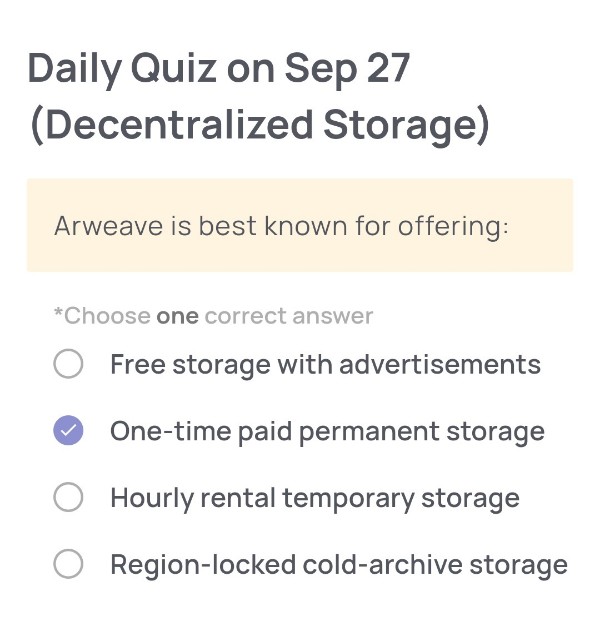
(Decentralized Storage)
🟢Quiz Questions:
Arweave is best known for offering:
🟢Choose one correct answer:
・Free storage with advertisements
・One-time paid permanent storage
・Hourly rental temporary storage
・Region-locked cold-archive storage
🟢Answer:
One-time paid permanent storage
🟢Reason for choosing this answer:
Arweave is a decentralized storage protocol designed for permanent data storage. Unlike subscription-based models such as Filecoin, Arweave uses a unique mechanism called the “permaweb”, where users make a one-time payment that funds storage indefinitely. This is achieved by storing data redundantly across many nodes, with incentives structured so the network maintains files permanently.
🟢Trivia:
Arweave is built on a blockchain-like structure called a Blockweave, which enables scalable permanent storage. Its token, AR, is used to pay miners upfront for data storage, and miners are rewarded for keeping data accessible over time. This long-term storage model has attracted projects archiving historical, cultural, and academic information, including partnerships with The Internet Archive and other open knowledge initiatives.
Daily Quiz on September 26
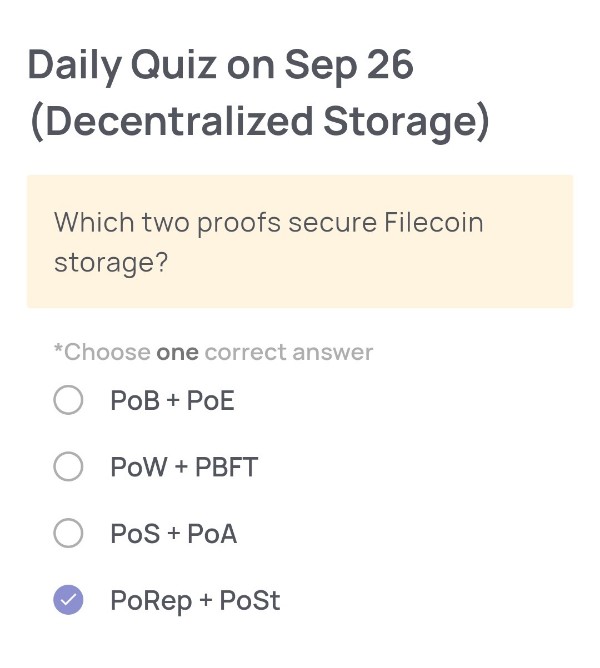
(Decentralized Storage)
🟢Quiz Questions:
Which two proofs secure Filecoin storage?
🟢Choose one correct answer:
・POB + POE
・POW + PBFT
・PoS + POA
・PoRep + PoSt
🟢Answer:
PoRep + PoSt
🟢Reason for choosing this answer:
Filecoin ensures decentralized storage integrity through two unique proofs:
- Proof-of-Replication (PoRep): Verifies that a storage provider has stored a unique copy of the client’s data in its own physical storage.
- Proof-of-Spacetime (PoSt): Verifies that the storage provider continues to store that data correctly over time.
Together, PoRep guarantees the data was initially stored properly, and PoSt ensures it remains stored continuously, creating a trustless and verifiable storage market.
🟢Trivia:
Unlike Proof-of-Work (Bitcoin) or Proof-of-Stake (Ethereum), Filecoin’s PoRep + PoSt consensus is specialized for storage. It allows providers to be rewarded for supplying real-world storage capacity rather than just computational power. This makes Filecoin one of the first blockchains to directly tie digital consensus with useful physical resources (data storage), bridging blockchain with real-world infrastructure.
Daily Quiz on September 25
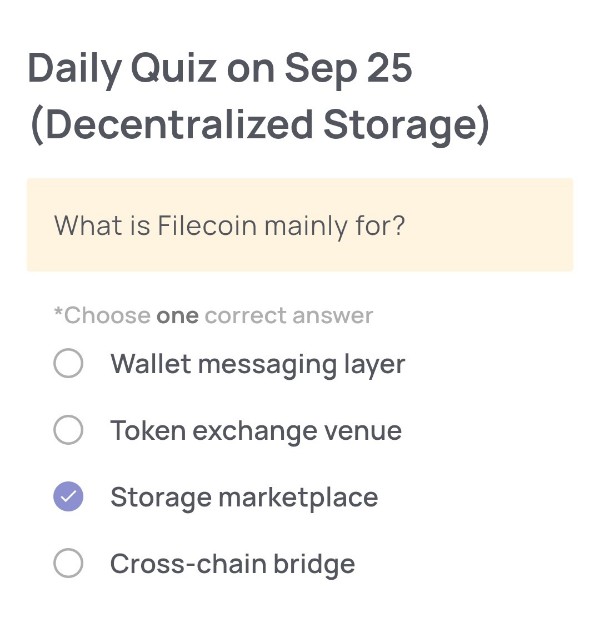
(Decentralized Storage)
🟢Quiz Questions:
What is Filecoin mainly for?
🟢Choose one correct answer:
・Wallet messaging layer
・Token exchange venue
・Storage marketplace
・Cross-chain bridge
🟢Answer:
Storage marketplace
🟢Reason for choosing this answer:
Filecoin is designed as a decentralized storage network where users can buy and sell storage space. Instead of relying on centralized cloud providers, Filecoin enables individuals and businesses to rent out unused storage capacity, creating a peer-to-peer marketplace secured by blockchain technology.
🟢Trivia:
Filecoin is built on top of the IPFS (InterPlanetary File System), a peer-to-peer network for sharing and storing files. While IPFS makes data accessible through unique content identifiers (CIDs), Filecoin adds an incentive layer by rewarding storage providers with FIL tokens. This ensures data persistence and reliability, making Filecoin one of the leading decentralized storage solutions in Web3.
Daily Quiz on September 24
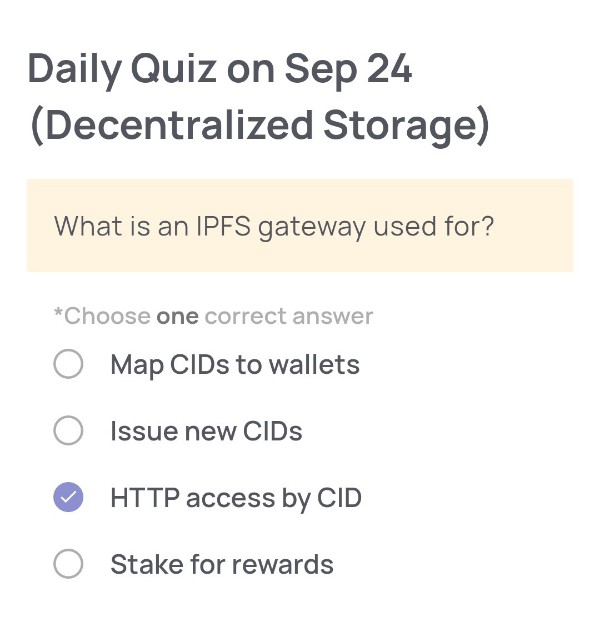
(Decentralized Storage)
🟢Quiz Questions:
What is an IPFS gateway used for?
🟢Choose one correct answer:
・Map CIDs to wallets
・Issue new CIDs
・HTTP access by CID
・Stake for rewards
🟢Answer:
HTTP access by CID
🟢Reason for choosing this answer:
An IPFS gateway allows users to access files stored on the InterPlanetary File System (IPFS) through a standard web browser using HTTP. Since IPFS identifies files by their Content Identifier (CID), the gateway maps the CID to a retrievable HTTP link, enabling easy access without needing to run an IPFS node locally.
🟢Trivia:
IPFS is a decentralized peer-to-peer storage system that uses content addressing (via CIDs) instead of location addressing (like URLs). While IPFS nodes normally communicate over a P2P protocol, gateways bridge the gap to the traditional web by letting you access decentralized content directly through links like https://ipfs.io/ipfs/{CID}. This makes IPFS more accessible to everyday users who are not running nodes themselves.
Daily Quiz on September 23
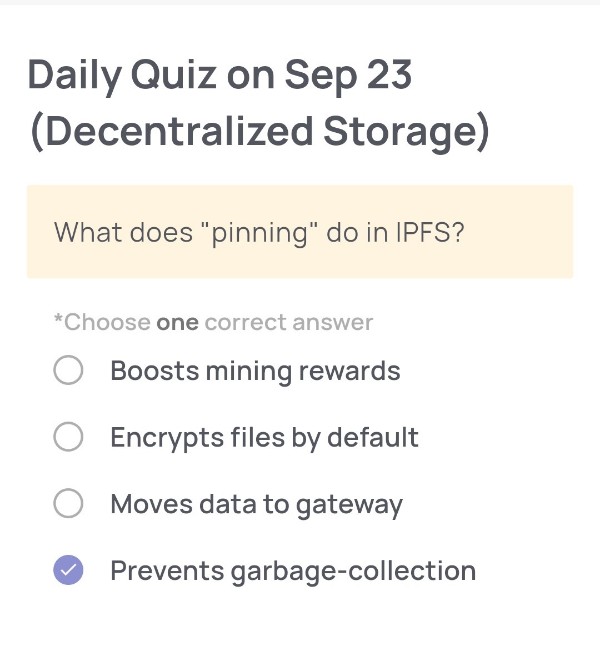
(Decentralized Storage)
🟢Quiz Questions:
What does “pinning” do in IPFS?
🟢Choose one correct answer:
・Boosts mining rewards
・Encrypts files by default
・Moves data to gateway
・Prevents garbage-collection
🟢Answer:
Prevents garbage-collection
🟢Reason for choosing this answer:
In IPFS (InterPlanetary File System), files are stored on a distributed network of peers. However, if no node “pins” the data, it may eventually be removed through garbage collection to free up storage space. Pinning ensures that the data remains persistently stored on a node, preventing automatic deletion and making it continuously available.
🟢Trivia:
Pinning is essential when using IPFS for decentralized applications (dApps) and NFTs. Many projects rely on “pinning services” such as Pinata or Infura to guarantee that critical data (like metadata or images for NFTs) remains accessible on the network. Without pinning, there’s no guarantee that content will remain online, which highlights the challenge of persistence in decentralized storage systems.
Daily Quiz on September 22
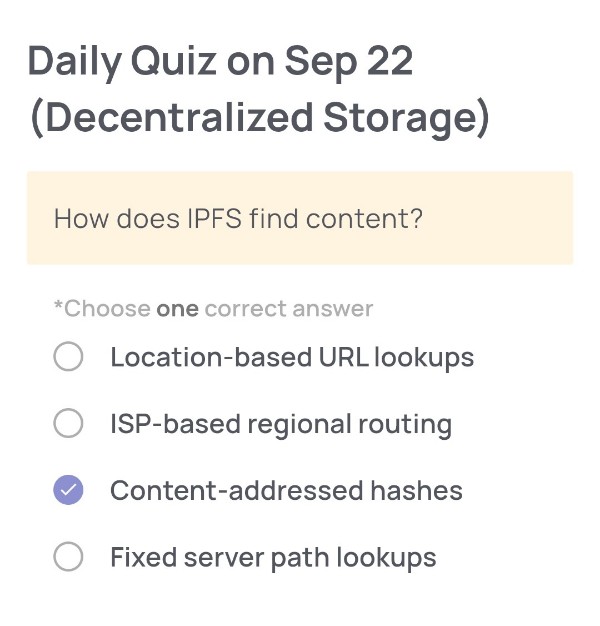
(Decentralized Storage)
🟢Quiz Question:
How does IPFS find content?
🟢Choose one correct answer:
・Location-based URL lookups
・ISP-based regional routing
・Content-addressed hashes
・Fixed server path lookups
🟢Answer:
Content-addressed hashes
🟢Reason for choosing this answer:
IPFS (InterPlanetary File System) is a peer-to-peer distributed file system that identifies and retrieves files based on their content rather than their location. Each file (or block of data) is given a unique cryptographic hash. When users request a file, the system looks up the hash across the distributed network instead of relying on a fixed server or URL. This makes IPFS resilient, decentralized, and tamper-proof, because any change to the content would result in a completely different hash.
🟢Trivia:
Unlike the traditional HTTP protocol, which fetches data from a specific server address (e.g., https://example.com/file.jpg), IPFS uses content addressing. For example, a file in IPFS might look like ipfs://Qm…hashvalue, meaning you can retrieve it from any node that stores it, not just one server. This allows for faster file retrieval, better fault tolerance, and reduces dependency on centralized hosting providers.
Daily Quiz on September 21
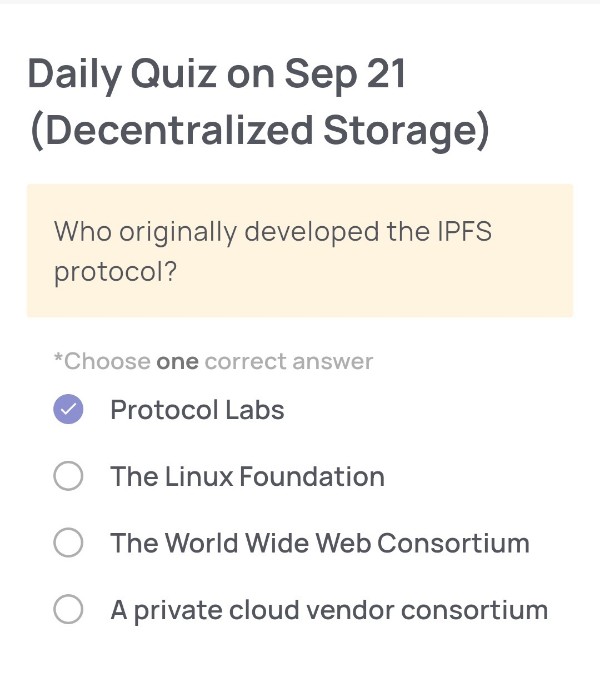
(Decentralized Storage)
🟢Quiz Questions:
Who originally developed the IPFS protocol?
🟢Choose one correct answer:
・Protocol Labs
・The Linux Foundation
・The World Wide Web Consortium
・A private cloud vendor consortium
🟢Answer:
Protocol Labs
🟢Reason for choosing this answer:
The IPFS (InterPlanetary File System) protocol was originally developed by Protocol Labs, a research and development company founded by Juan Benet. Protocol Labs is focused on building open-source, decentralized technologies, and IPFS is one of their flagship projects. The other listed organizations, such as the Linux Foundation or W3C, are major standardization and open-source bodies, but they were not behind the creation of IPFS.
🟢Trivia:
Protocol Labs is also the creator of Filecoin, a decentralized storage network that incentivizes users to share unused disk space. IPFS and Filecoin are complementary — while IPFS handles content addressing and peer-to-peer file sharing, Filecoin provides an economic layer that ensures data persistence. Today, IPFS is widely used in blockchain ecosystems, including NFT storage, decentralized applications, and Web3 infrastructure.
Daily Quiz on September 20
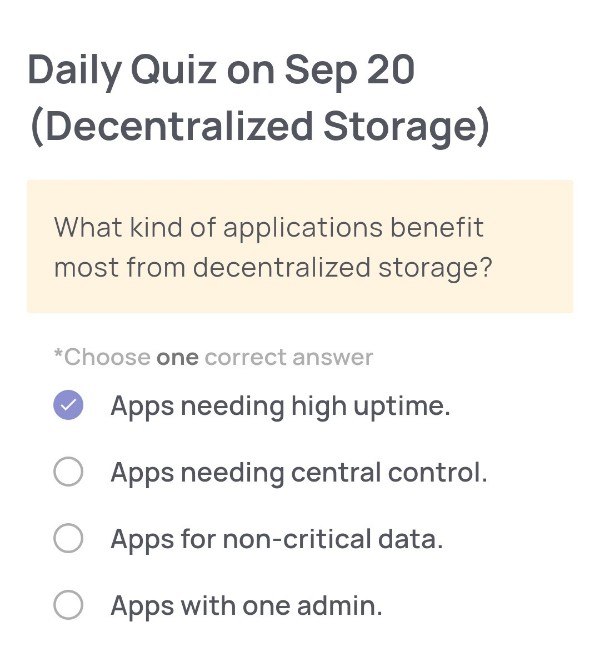
(Decentralized Storage)
🟢Quiz Questions:
What kind of applications benefit most from decentralized storage?
🟢Choose one correct answer:
・Apps needing high uptime.
・Apps needing central control.
・Apps for non-critical data.
・Apps with one admin.
🟢Answer:
Apps needing high uptime.
🟢Reason for choosing this answer:
Decentralized storage distributes data across many independent nodes, making it resilient to single points of failure. This ensures high availability and fault tolerance, which is critical for applications that must remain online and accessible at all times. By contrast, apps requiring central control or limited administration typically benefit more from centralized solutions, not decentralized ones.
🟢Trivia:
Xenea’s DACS (Decentralized Autonomous Content Storage) goes beyond traditional decentralized storage like IPFS by supporting real-time editing of dynamic data and long-term data persistence. This makes it ideal not only for high-uptime applications but also for future AI and DePIN (Decentralized Physical Infrastructure Network) use cases, where reliability and continuity are essential.
Daily Quiz on September 19
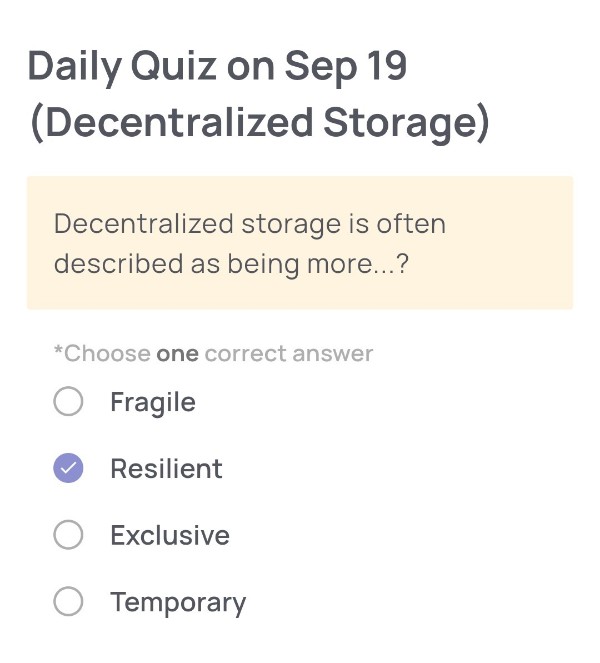
🟢Quiz Questions:
Decentralized storage is often described as being more…?
🟢Choose one correct answer:
・Fragile
・Resilient
・Exclusive
・Temporary
🟢Answer:
Resilient
🟢Reason for choosing this answer:
Decentralized storage is considered resilient because data is distributed across multiple nodes rather than being stored in a single centralized server. This structure reduces the risk of a single point of failure and makes the system more resistant to data loss, hacking, or outages. Even if some nodes fail or are attacked, the data can still be retrieved from other nodes.
🟢Trivia:
Xenea integrates a unique decentralized storage system called DACS (Decentralized Autonomous Content Storage). Unlike traditional systems such as IPFS/Filecoin, DACS is designed to ensure long-term data persistence and real-time editing of dynamic data, making it more reliable for future AI and Web3 use cases. This means not only resilience against failures but also adaptability for evolving data requirements.
Daily Quiz on September 18
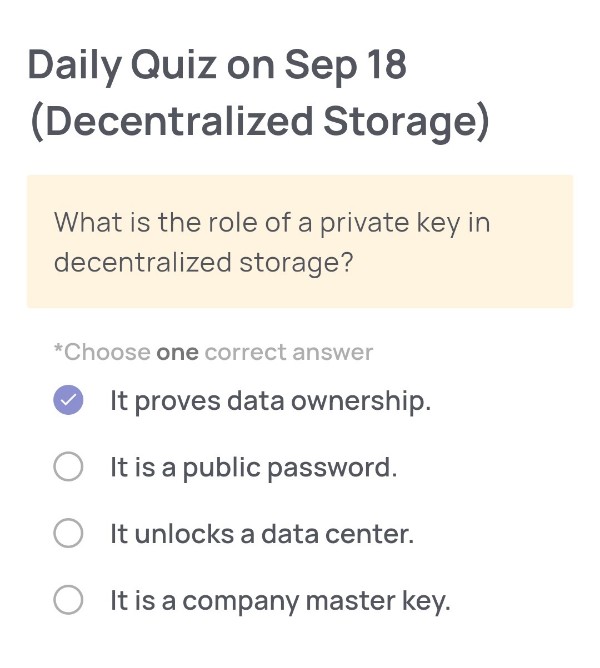
(Decentralized Storage)
🟢Quiz Questions:
What is the role of a private key in decentralized storage?
🟢Choose one correct answer:
・It proves data ownership.
・It is a public password.
・It unlocks a data center.
・It is a company master key.
🟢Answer:
It proves data ownership.
🟢Reason for choosing this answer:
In decentralized storage and blockchain systems, a private key is a cryptographic element that allows users to prove ownership and control over their data or assets. Without the private key, one cannot authorize access, make changes, or sign transactions. It is not shared publicly and is never used as a “password” in the traditional sense, nor does it control physical infrastructure like data centers or represent a centralized company’s master access key.
🟢Trivia:
Technologies like Shamir Secret Sharing (SSS) and MPC (Multi-Party Computation) can split a private key into multiple fragments and distribute them across different nodes. This method, used in wallets like XENEA Wallet, enhances security by ensuring that the complete key is never stored in one place, reducing the risk of hacking or data loss.
Daily Quiz on September 17
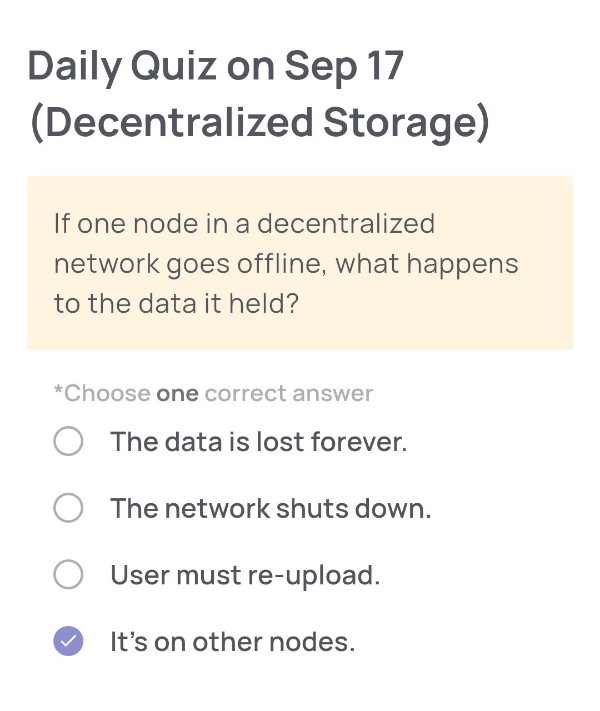
(Decentralized Storage)
🟢Quiz Questions:
If one node in a decentralized network goes offline, what happens to the data it held?
🟢Choose one correct answer:
・The data is lost forever.
・The network shuts down.
・User must re-upload.
・It’s on other nodes.
🟢Answer:
It’s on other nodes.
🟢Reason for choosing this answer:
In decentralized storage systems like DACS (Decentralized Autonomous Content Storage), data is not stored in just one location but is distributed across multiple nodes in the network. Even if a single node goes offline, the data remains accessible from other nodes that hold replicated or split parts of it. This redundancy ensures fault tolerance and persistence, which are core features of decentralized storage.
🟢Trivia:
Xenea’s DACS goes a step beyond traditional decentralized storage by supporting real-time editing of dynamic data and ensuring data continuity across generations. This makes it more advanced compared to IPFS or Filecoin, which primarily focus on static file storage. The design ensures that even large files like videos or AI-generated data can be preserved reliably, independent of any single node’s status.
Daily Quiz on September 16
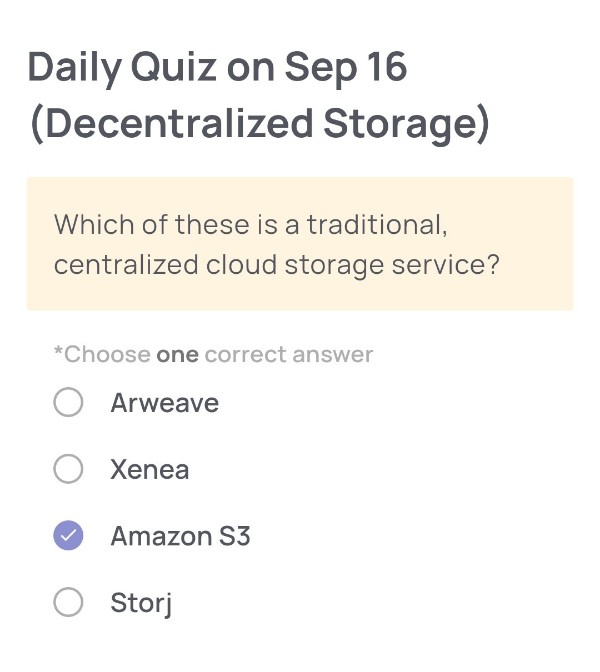
(Decentralized Storage)
🟢Quiz Questions:
Which of these is a traditional, centralized cloud storage service?
🟢Choose one correct answer:
・Arweave
・Xenea
・Amazon S3
・Storj
🟢Answer:
Amazon S3
🟢Reason for choosing this answer:
Amazon S3 (Simple Storage Service) is a centralized cloud storage service operated by Amazon Web Services (AWS). Unlike decentralized storage solutions such as Arweave, Storj, or Xenea’s DACS, Amazon S3 relies on Amazon’s centralized infrastructure where data is stored and managed within Amazon’s servers. This makes it fundamentally different from decentralized, peer-to-peer storage systems.
🟢Trivia:
Amazon S3 was launched in 2006 and has become one of the most widely used centralized storage services in the world. It is designed for scalability, durability, and high availability, storing trillions of objects globally. However, since it is centralized, data storage and access are subject to Amazon’s control and policies, whereas decentralized storage networks like Arweave, Storj, and Xenea aim to remove single points of failure and provide censorship-resistant storage.
Daily Quiz on September 15
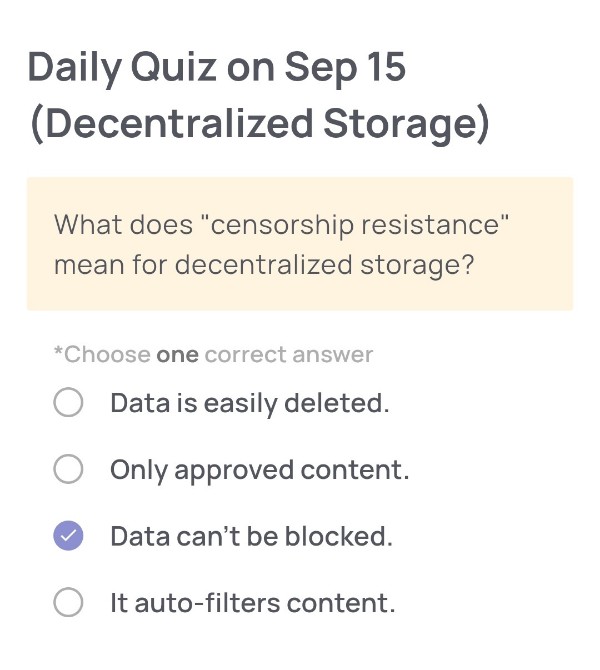
(Decentralized Storage)
🟢Quiz Questions:
What does “censorship resistance” mean for decentralized storage?
🟢Choose one correct answer:
・Data is easily deleted.
・Only approved content.
・Data can’t be blocked.
・It auto-filters content.
🟢Answer:
Data can’t be blocked.
🟢Reason for choosing this answer:
Censorship resistance in decentralized storage means that once data is stored on the network, no single authority (government, corporation, or individual) can prevent others from accessing it or delete it at will. Unlike centralized servers, decentralized storage distributes data across multiple nodes, ensuring availability and preventing control by a single point of failure or censorship.
🟢Trivia:
Xenea’s Decentralized Autonomous Content Storage (DACS) embodies this principle by integrating decentralized storage directly into its blockchain. This ensures not only data persistence across generations but also that information cannot be unfairly restricted or removed. Similar to how IPFS promotes open access to data, DACS expands the concept with real-time dynamic data editing and ultra-long-term preservation.
Daily Quiz on September 14
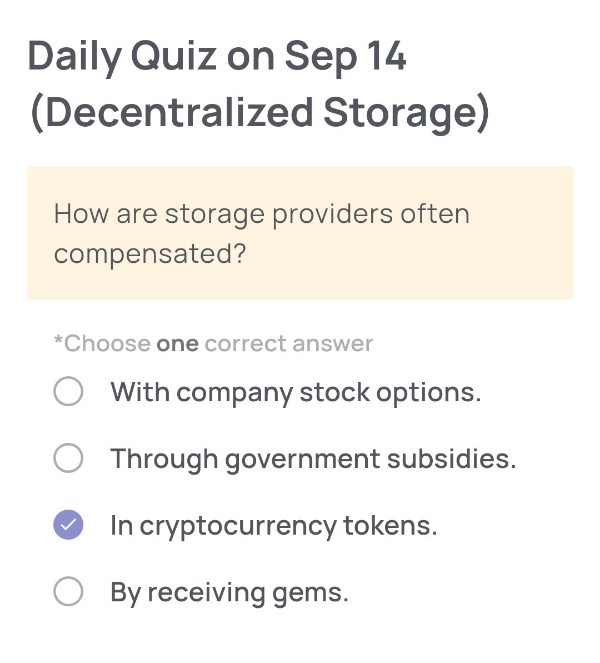
(Decentralized Storage)
🟢Quiz Questions:
How are storage providers often compensated?
🟢Choose one correct answer:
・With company stock options.
・Through government subsidies.
・In cryptocurrency tokens.
・By receiving gems.
🟢Answer:
In cryptocurrency tokens.
🟢Reason for choosing this answer:
In decentralized storage networks such as Xenea’s DACS (Decentralized Autonomous Content Storage) or similar systems like Filecoin, storage providers (node operators) are compensated with cryptocurrency tokens for providing storage space and maintaining data availability. This creates a direct economic incentive within the blockchain ecosystem without relying on centralized institutions or subsidies.
🟢Trivia:
Xenea’s DACS not only rewards storage providers with $XENE tokens but also integrates storage incentives directly into its blockchain architecture. For example, XENEA Genesis Node NFTs launched in 2025 give holders rights to receive block rewards from both consensus (PoD) and storage (DACS) operations. This model is similar to Filecoin but extends to support real-time dynamic data editing, making it suitable for AI and DePIN applications.
Daily Quiz on September 13
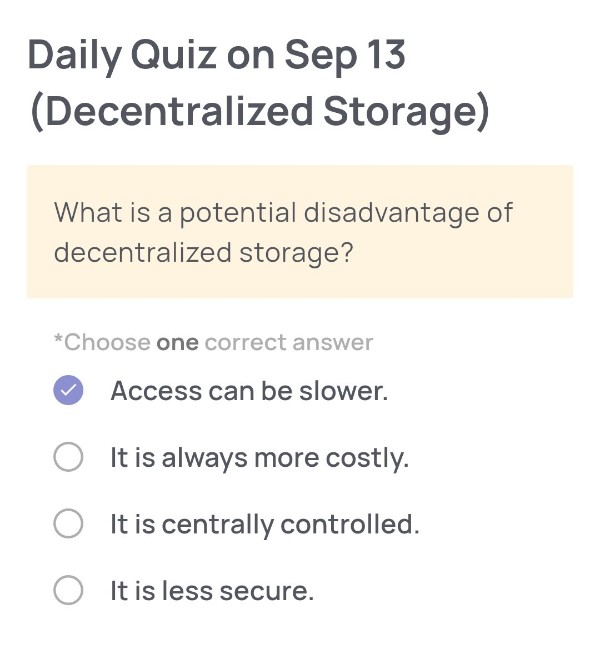
(Decentralized Storage)
🟢Quiz Questions:
What is a potential disadvantage of decentralized storage?
🟢Choose one correct answer:
・Access can be slower.
・It is always more costly.
・It is centrally controlled.
・It is less secure.
🟢Answer:
Access can be slower.
🟢Reason for choosing this answer:
In decentralized storage, data is distributed across multiple nodes rather than stored in a single centralized server. While this improves redundancy and security, it can result in slower access times because retrieving data may require communication with several different nodes, sometimes across different geographic regions. This is in contrast to centralized systems, which can optimize for speed using dedicated infrastructure.
🟢Trivia:
Xenea’s DACS (Decentralized Autonomous Content Storage) is designed to overcome this limitation by introducing mechanisms for data persistence and instant accessibility. Unlike traditional decentralized storage systems like IPFS, which may suffer from latency issues, DACS integrates directly into the blockchain and supports features such as real-time editing of dynamic data. This positions Xenea as one of the first blockchain platforms to combine secure decentralization with efficient data handling for AI and Web3 applications.
Daily Quiz on September 12
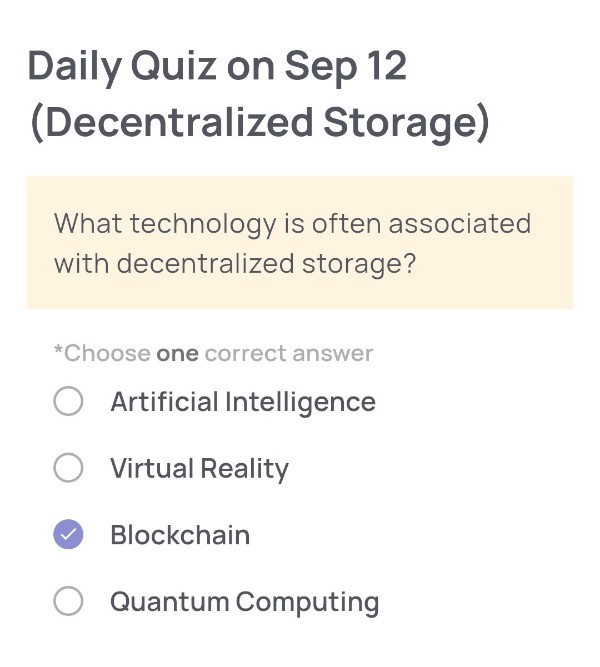
(Decentralized Storage)
🟢Quiz Questions:
What technology is often associated with decentralized storage?
🟢Choose one correct answer:
・Artificial Intelligence
・Virtual Reality
・Blockchain
・Quantum Computing
🟢Answer:
Blockchain
🟢Reason for choosing this answer:
Decentralized storage relies on distributed ledger technology, and blockchain provides the underlying infrastructure that ensures data integrity, immutability, and transparency across multiple nodes. Unlike centralized servers, blockchain enables files and data to be securely stored in a decentralized network, making it a core technology behind systems like IPFS, Filecoin, and Xenea’s DACS (Decentralized Autonomous Content Storage).
🟢Trivia:
Xenea integrates DACS (Decentralized Autonomous Content Storage) directly into its Layer 1 blockchain. This allows not only permanent storage of data but also new capabilities like real-time editing of dynamic data, which traditional decentralized storage systems (e.g., IPFS) do not support. This makes Xenea one of the first platforms to combine blockchain security with next-generation decentralized storage for both static and dynamic content.
Daily Quiz on September 11
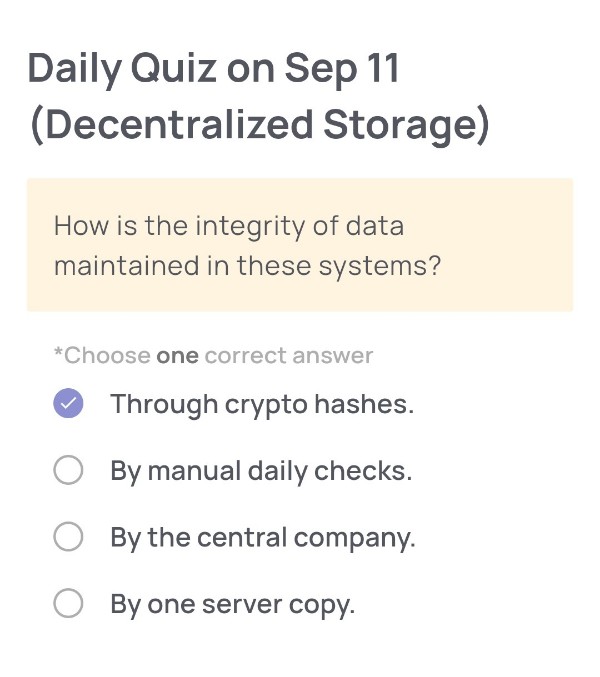
(Decentralized Storage)
🟢Quiz Questions:
How is the integrity of data maintained in these systems?
🟢Choose one correct answer:
・Through crypto hashes.
・By manual daily checks.
・By the central company.
・By one server copy.
🟢Answer:
Through crypto hashes.
🟢Reason for choosing this answer:
In decentralized storage systems such as Xenea’s Decentralized Autonomous Content Storage (DACS), data integrity is maintained using cryptographic hashes. When a file is stored, a unique hash is generated based on its contents. Any change, even a single bit, alters the hash, making tampering immediately detectable. Unlike centralized checks or relying on a single server, crypto hashes ensure that data is verifiable across the distributed network without requiring trust in a central authority.
🟢Trivia:
The concept of using cryptographic hashes for data integrity is also the foundation of blockchains. Bitcoin, Ethereum, and Xenea all rely on hashes to link blocks and verify transactions. In storage systems, hashes not only verify authenticity but also act as addresses for retrieving files (as seen in IPFS). This makes them essential for ensuring data permanence and trust in decentralized networks.
Daily Quiz on September 10
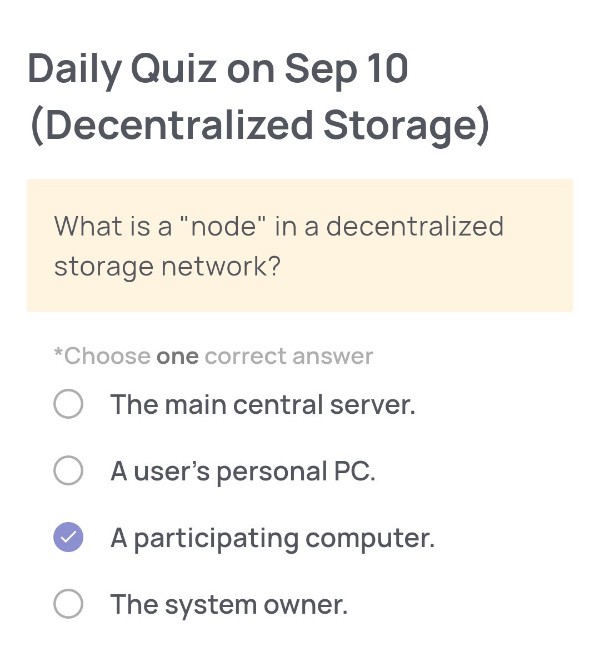
(Decentralized Storage)
🟢Quiz Questions:
What is a “node” in a decentralized storage network?
🟢Choose one correct answer:
・The main central server.
・A user’s personal PC.
・A participating computer.
・The system owner.
🟢Answer:
A participating computer.
🟢Reason for choosing this answer:
In a decentralized storage network, there is no single central server controlling data. Instead, multiple independent computers (called “nodes”) participate in storing, verifying, and sharing data. Each node contributes resources to the network, ensuring resilience, fault tolerance, and decentralization. Unlike a personal PC that may just consume services, a “node” actively participates in the network’s operation.
🟢Trivia:
Decentralized storage systems like IPFS, Filecoin, and Xenea’s DACS (Decentralized Autonomous Content Storage) use nodes to distribute data across many participants. This makes the system more secure and censorship-resistant. In Xenea, for example, DACS nodes provide long-term, tamper-proof storage of data and earn rewards for their participation.
Daily Quiz on September 9
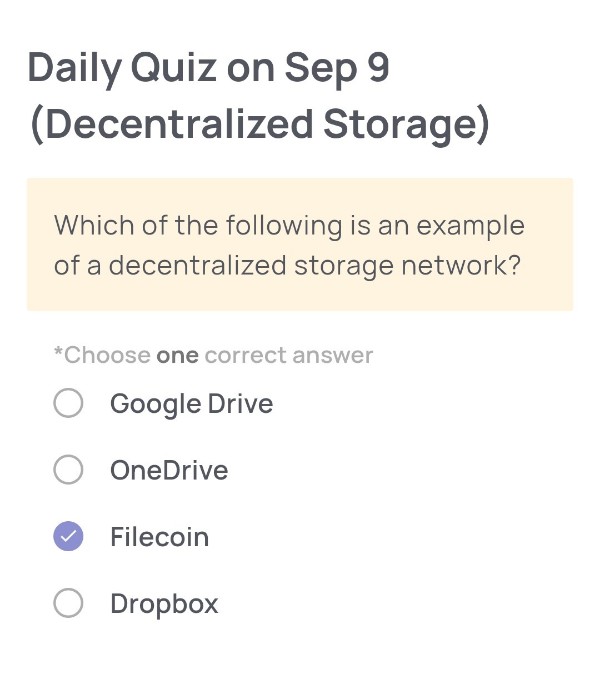
(Decentralized Storage)
🟢Quiz Questions:
Which of the following is an example of a decentralized storage network?
🟢Choose one correct answer:
・Google Drive
・OneDrive
・Filecoin
・Dropbox
🟢Answer:
Filecoin
🟢 Reason for choosing this answer:
Filecoin is a decentralized storage network built on blockchain technology. Unlike centralized services such as Google Drive, OneDrive, or Dropbox, which store user data on servers controlled by specific companies, Filecoin uses a distributed network of independent storage providers. This ensures that data is stored across multiple nodes, enhancing security, censorship resistance, and long-term availability.
🟢 Trivia:
Filecoin is built on top of IPFS (InterPlanetary File System), a peer-to-peer protocol for storing and sharing files. While IPFS provides the framework for decentralized file storage and retrieval, Filecoin adds an incentive layer, rewarding storage providers with FIL tokens. This combination makes Filecoin one of the most widely recognized decentralized storage solutions in the Web3 ecosystem.
Daily Quiz on September 8
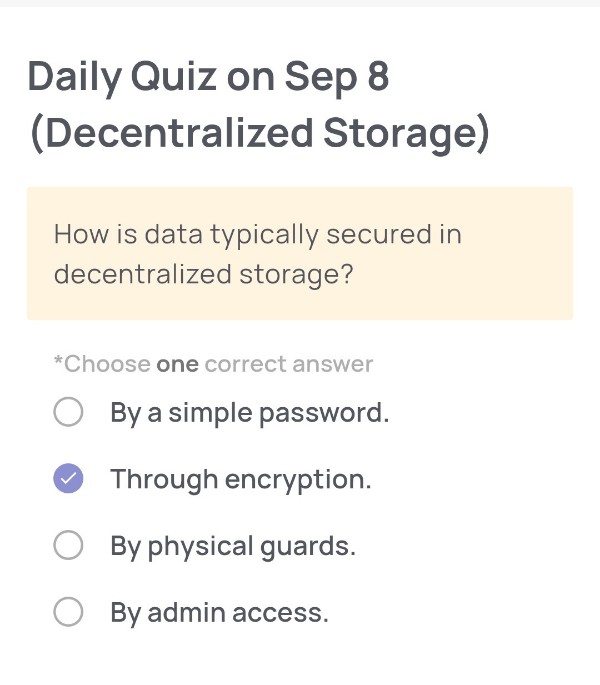
(Decentralized Storage)
🟢Quiz Questions:
How is data typically secured in decentralized storage?
🟢Choose one correct answer:
・By a simple password.
・Through encryption.
・By physical guards.
・By admin access.
🟢Answer:
Through encryption.
🟢Reason for choosing this answer:
Decentralized storage systems, such as IPFS or Filecoin, distribute data across multiple nodes in a network. To ensure that only authorized users can access the data, encryption is used. Unlike centralized systems that rely heavily on administrator privileges or single points of control, decentralized storage emphasizes cryptographic methods. Encryption ensures confidentiality and integrity, even when data fragments are stored across many independent nodes.
🟢Trivia:
A common method used is end-to-end encryption combined with sharding (splitting files into encrypted pieces). Each shard is distributed across different nodes, and only the user with the correct decryption key can reconstruct the original file. This not only secures the data but also enhances redundancy and resistance to censorship.
Daily Quiz on September 7
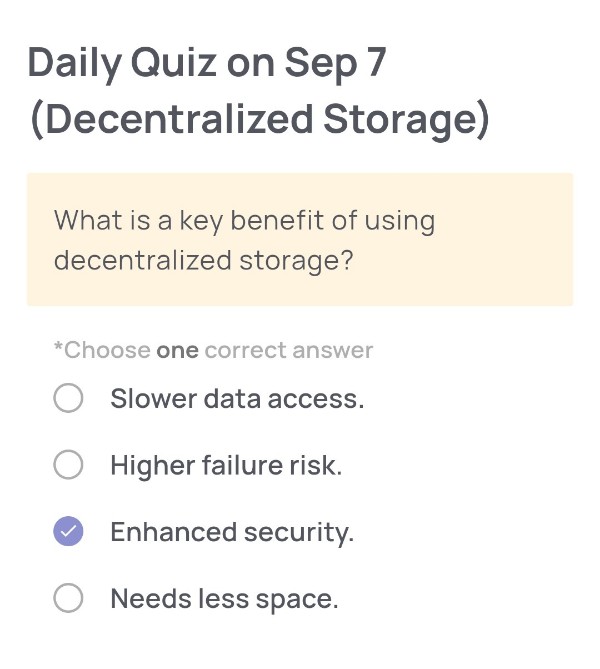
(Decentralized Storage)
🟢Quiz Questions:
What is a key benefit of using decentralized storage?
🟢Choose one correct answer:
・Slower data access.
・Higher failure risk.
・Enhanced security.
・Needs less space.
🟢Answer:
Enhanced security.
🟢Reason for choosing this answer:
Decentralized storage distributes data across multiple independent nodes rather than storing it in a single centralized server. This significantly reduces the risks of data breaches, hacking, or single points of failure. Even if one node is compromised, the data remains safe because it is encrypted and redundantly stored across the network.
🟢Trivia:
Xenea’s Decentralized Autonomous Content Storage (DACS) is an advanced form of decentralized storage. Unlike traditional file systems such as IPFS, DACS ensures not only persistence but also real-time editing of dynamic data, making it suitable for AI and Web3 use cases. This innovation helps protect user data across generations while maintaining strong security and reliability.
Daily Quiz on September 6
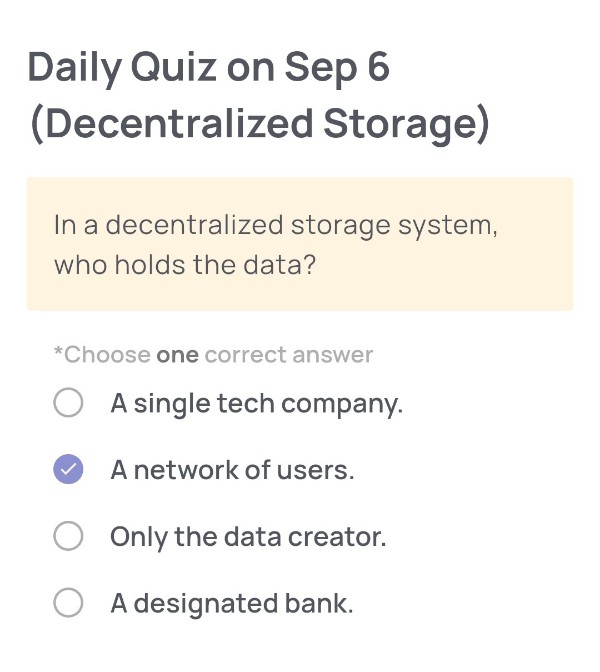
(Decentralized Storage)
🟢Quiz Questions:
In a decentralized storage system, who holds the data?
🟢Choose one correct answer:
・A single tech company.
・A network of users.
・Only the data creator.
・A designated bank.
🟢Answer:
A network of users.
🟢Reason for choosing this answer:
In a decentralized storage system, data is not controlled by a single company or centralized authority. Instead, it is distributed across a network of independent users (nodes). Each node stores a portion of the data or helps verify its availability, ensuring that no single party has complete control. This structure improves security, resilience, and censorship resistance compared to centralized systems.
🟢Trivia:
Decentralized storage technologies, such as IPFS (InterPlanetary File System) and Xenea’s DACS (Decentralized Autonomous Content Storage), store data across multiple nodes worldwide. This makes the system resistant to single points of failure. For example, if one server goes offline, the data can still be retrieved from other nodes. Xenea’s approach even supports long-term data continuity and real-time editing of dynamic data, making it suitable for AI and Web3 use cases.
Daily Quiz on September 5
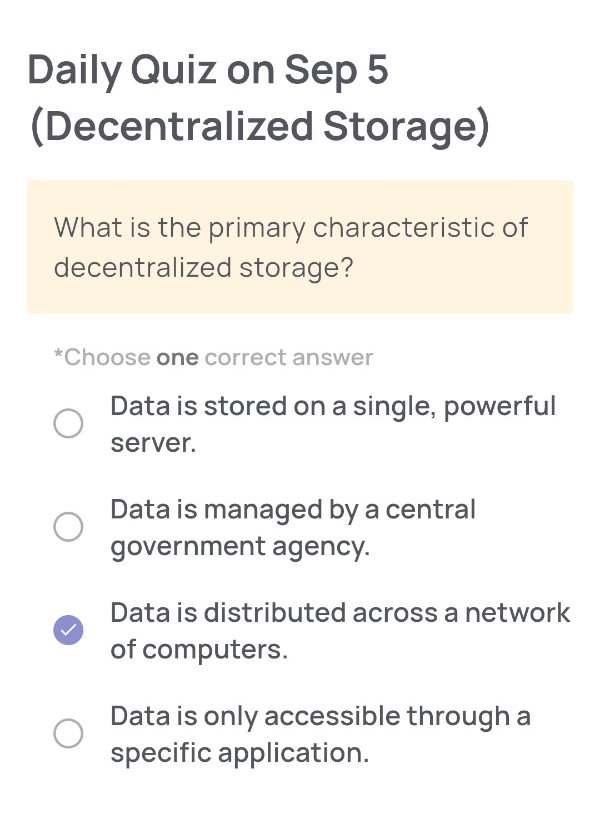
(Decentralized Storage)
🟢Quiz Questions:
What is the primary characteristic of decentralized storage?
🟢Choose one correct answer:
・Data is stored on a single, powerful server.
・Data is managed by a central government agency.
・Data is distributed across a network of computers.
・Data is only accessible through a specific application.
🟢Answer:
Data is distributed across a network of computers.
🟢Reason for choosing this answer:
The essence of decentralized storage lies in eliminating reliance on a single entity or server. Instead, data is split and stored across multiple nodes in a distributed network, ensuring redundancy, resistance to censorship, and improved fault tolerance. This approach contrasts with centralized systems, where a single point of failure could compromise access or security.
🟢Trivia:
Xenea’s decentralized storage system, called DACS (Decentralized Autonomous Content Storage), builds on this principle by allowing data to be securely stored across multiple nodes. Unlike traditional IPFS/Filecoin, DACS introduces mechanisms for long-term persistence and even real-time editing of dynamic data, making it especially suitable for the AI and Web3 era.
Daily Quiz on September 4
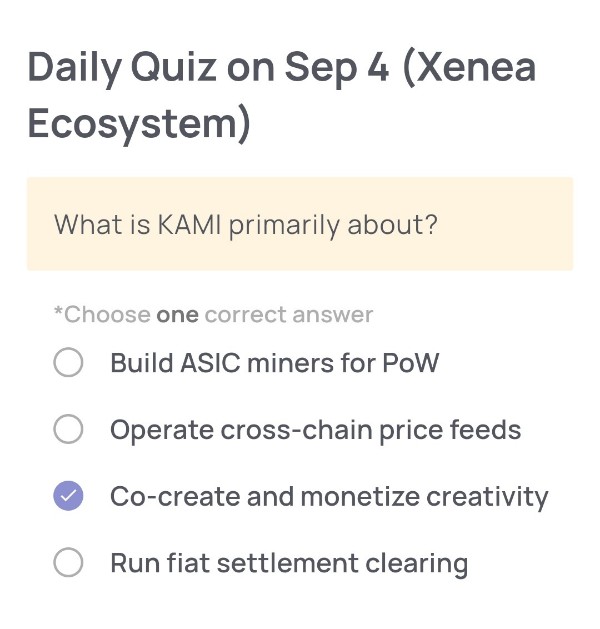
(Xenea Ecosystem)
🟢Quiz Questions:
What is KAMI primarily about?
🟢Choose one correct answer:
・Build ASIC miners for PoW
・Operate cross-chain price feeds
・Co-create and monetize creativity
・Run fiat settlement clearing
🟢Answer:
Co-create and monetize creativity
🟢Reason for choosing this answer:
KAMI is an initiative within the Xenea ecosystem that focuses on creativity and community-driven content. Unlike technical infrastructure projects (ASIC miners, cross-chain price feeds, or fiat settlement), KAMI emphasizes collaboration in creative works and enabling monetization through Web3 tools. This aligns with Xenea’s broader mission of empowering user participation and decentralization beyond just financial transactions.
🟢Trivia:
The name “KAMI” is inspired by the Japanese word for “god” or “paper,” symbolizing both creation and expression. In the Xenea ecosystem, KAMI serves as a creative economy layer, where users can co-create digital works (art, content, experiences) and share revenue streams. This approach reflects a growing trend in Web3, where communities are not only consumers but also active contributors and owners of value.
Daily Quiz on September 3
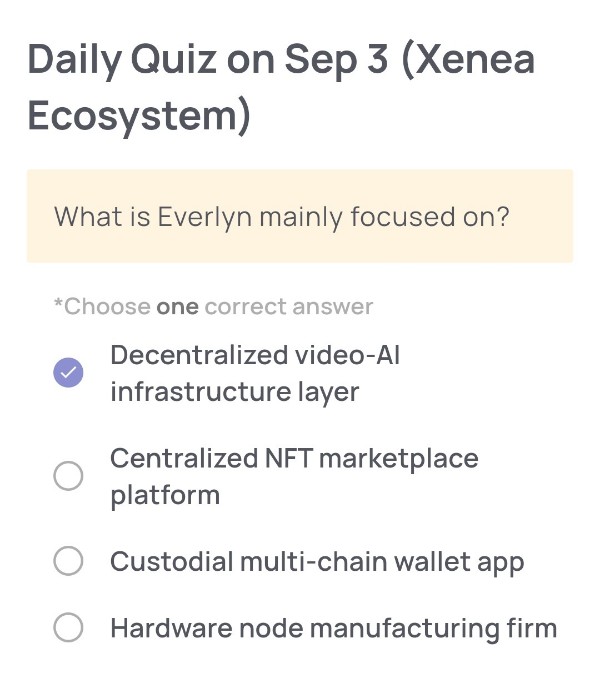
(Xenea Ecosystem)
🟢Quiz Questions:
What is Everlyn mainly focused on?
🟢Choose one correct answer:
・Decentralized video-Al infrastructure layer
・Centralized NFT marketplace platform
・Custodial multi-chain wallet app
・Hardware node manufacturing firm
🟢Answer:
Decentralized video-Al infrastructure layer
🟢Reason for choosing this answer:
Everlyn is part of the Xenea ecosystem and is specifically positioned as a decentralized infrastructure layer for video AI. Its focus is on providing a foundation where AI-powered video services can run in a decentralized manner, rather than relying on centralized platforms. This aligns with Xenea’s broader mission of building decentralized, user-empowered applications and services.
🟢Trivia:
Decentralized video AI infrastructure enables AI models for video analysis, streaming, and content generation to operate on distributed networks. This reduces the reliance on centralized servers, improving censorship resistance and resilience. It also opens up opportunities for contributors to provide computing power and earn rewards, similar to how blockchain miners or validators are incentivized.
Daily Quiz on September 2
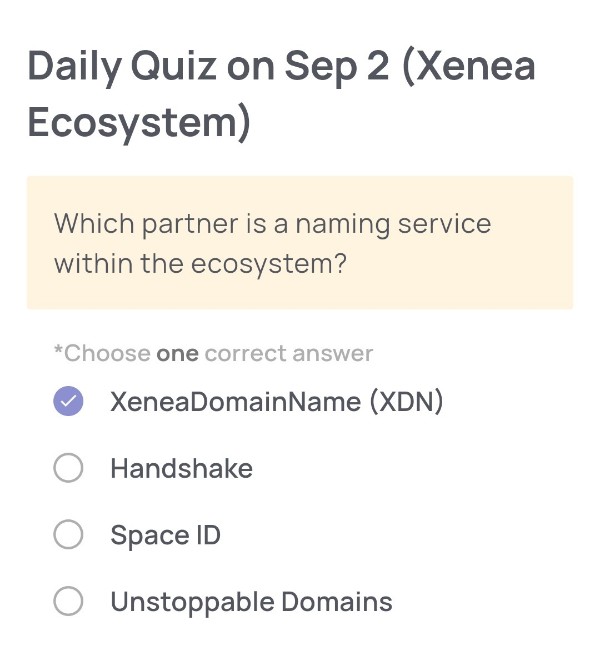
(Xenea Ecosystem)
🟢Quiz Question:
Which partner is a naming service within the ecosystem?
🟢Choose one correct answer:
・XeneaDomainName (XDN)
・Handshake
・Space ID
・Unstoppable Domains
🟢Answer:
XeneaDomainName (XDN)
🟢Reason for choosing this answer:
XeneaDomainName (XDN) is specifically designed as the official naming service within the Xenea ecosystem, enabling users to register and manage decentralized domain names linked to their Xenea Wallet addresses. While Handshake, Space ID, and Unstoppable Domains are well-known naming services in the broader Web3 ecosystem, only XDN is directly integrated as a native partner of Xenea.
🟢Trivia:
A blockchain naming service functions like a Web3 version of DNS (Domain Name System), allowing human-readable names (e.g., alice.xdn) instead of long wallet addresses. This makes transactions easier and reduces errors. Interestingly, XeneaDomainName (XDN) is tailored to work seamlessly with the Xenea Wallet and the Proof of Democracy (PoD) ecosystem, ensuring not just convenience but also long-term persistence of domain ownership.
Daily Quiz on September 1
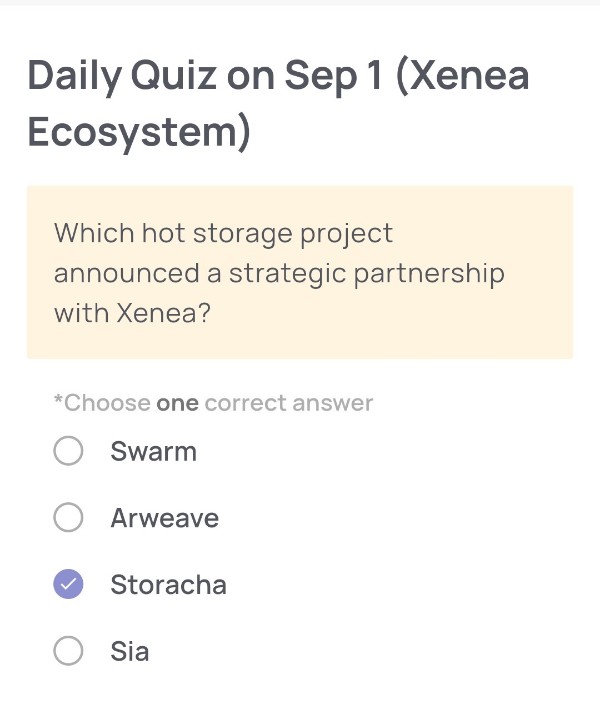
(Xenea Ecosystem)
Which hot storage project announced a strategic partnership with Xenea?
🟢Choose one correct answer:
・Swarm
・Arweave
・Storacha
・Sia
🟢Answer:
Storacha
🟢Reason for choosing this answer:
Xenea officially announced a strategic partnership with Storacha, a decentralized hot storage solution, to enhance its hot-layer storage capabilities and bolster its dynamic storage infrastructure—clearly signaling Storacha as the correct choice.
🟢Trivia:
・Storacha provides blazing-fast, decentralized “hot storage” by integrating with IPFS and Filecoin. It’s specifically designed to address challenges like slow data retrieval and unreliable indexing—key pain points for decentralized systems.
・This collaboration empowers developers within the Xenea ecosystem to benefit from high-performance storage without compromising decentralization, reducing developer overhead, and enabling scalable, real-world ready infrastructure.
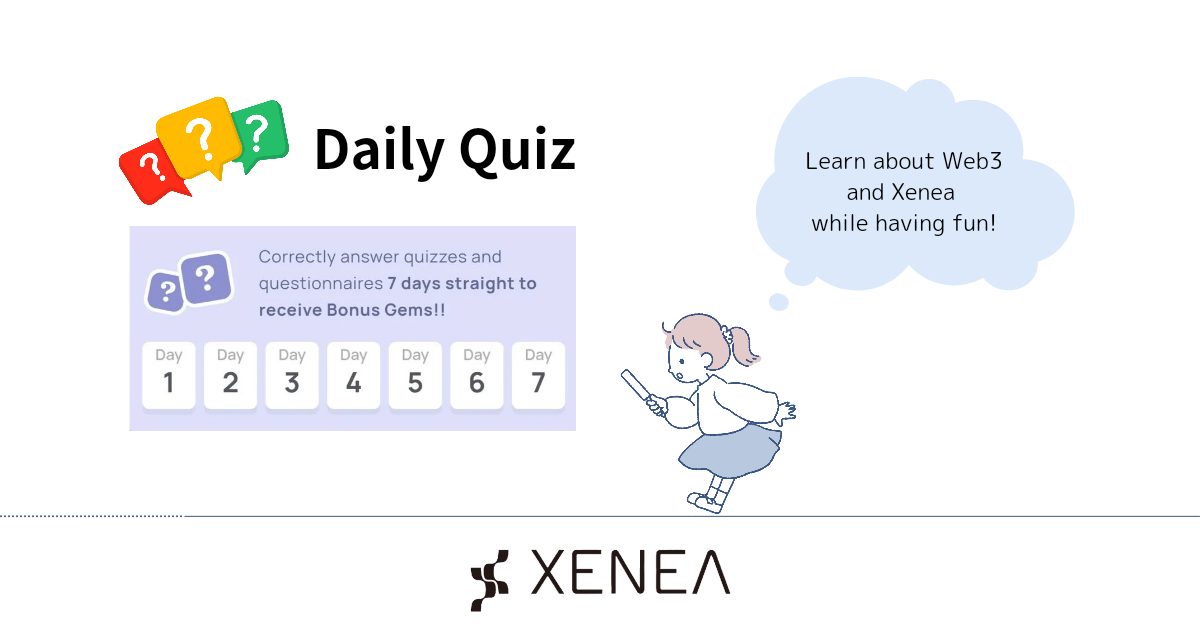
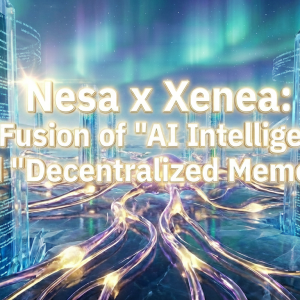
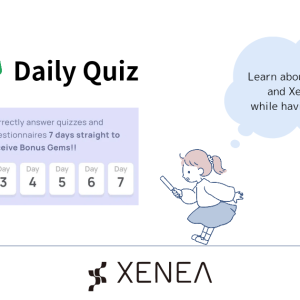
Comment